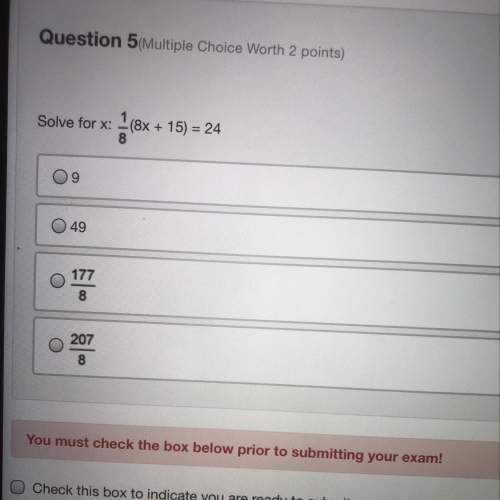Consider the two-way table below.
A 4-column table has 3 rows. The first column has entr...

Mathematics, 04.04.2020 21:30 bbb4951
Consider the two-way table below.
A 4-column table has 3 rows. The first column has entries A, B, total. The second column is labeled C with entries 15, 9, 24. The third column is labeled D with entries 21, 25, 46. The fourth column is labeled Total with entries 36, 34, 70.
Find P(B|C).
P(B|C) = StartFraction 9 Over 34 EndFraction = 0.26
P(B|C) = StartFraction 9 Over 24 EndFraction = 0.38
P(B|C) = StartFraction 9 Over 70 EndFraction = 0.13
P(B|C) = StartFraction 9 Over 58 EndFraction = 0.16

Answers: 1


Another question on Mathematics

Mathematics, 21.06.2019 19:00
[10 points, algebra 2]according to my answer key the restrictions are -1 and 4. but why not positive 1?
Answers: 1

Mathematics, 21.06.2019 19:40
Which is the solution to the inequality? 2 3/52 1/15 b< 3 2/15 b> 3 2/15
Answers: 1

Mathematics, 21.06.2019 20:30
For the quadratic function [tex]y=(x+4)^2-1[/tex] , do the following: a) rewrite the function in the standard form, b) rewrite the function in intercept form, c) find the vertex, d) find the y-intercept, e) find the x-intercepts.
Answers: 1

Mathematics, 21.06.2019 21:30
50 people men and women were asked if they watched at least one sport on tv. 20 of the people surveyed are women, but only 9 of them watch at least one sport on tv. 16 of the men watch at least one sport on tv. make a a two-way table and a relative frequency table to represent the data.
Answers: 3
You know the right answer?
Questions

Mathematics, 16.01.2022 14:00




Social Studies, 16.01.2022 14:00


Mathematics, 16.01.2022 14:00

English, 16.01.2022 14:00






Mathematics, 16.01.2022 14:00

Mathematics, 16.01.2022 14:00

Mathematics, 16.01.2022 14:00


Social Studies, 16.01.2022 14:00






